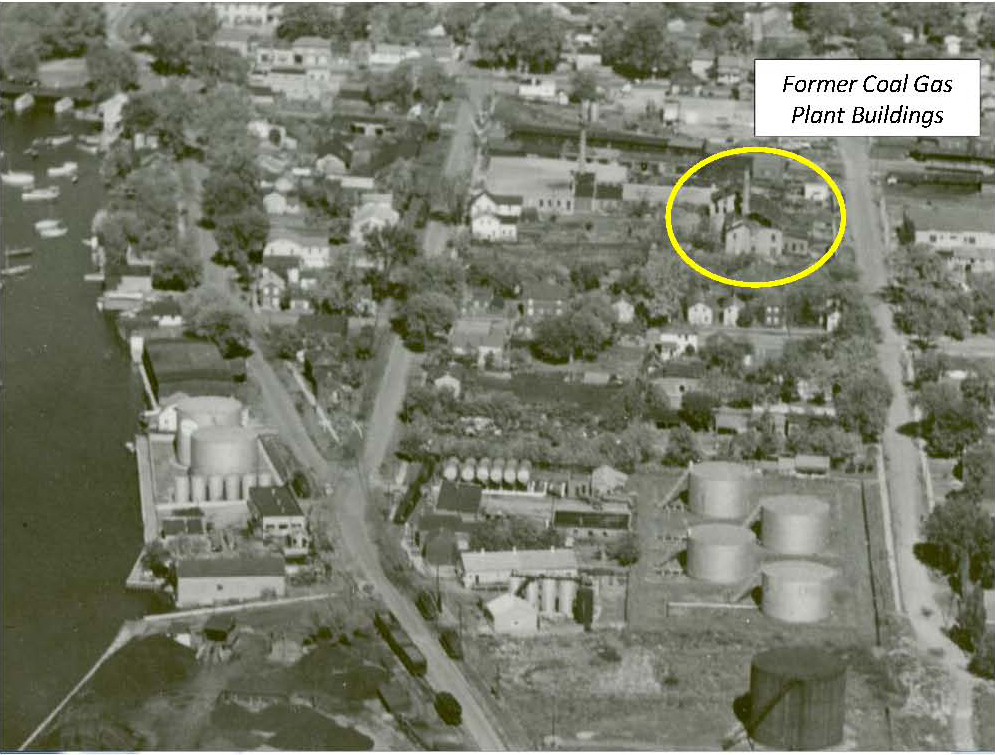Starting in the late 1800s, communities throughout North America produced coal gas as fuel for heating and lighting. The coal gas was produced by heating coal and other ingredients in large brick ovens, collecting and filtering the coal gas and then storing the coal gas in tanks. A by-product of the manufacture of coal gas was coal tar. Coal tar was sold as a product and excess coal tar was disposed of as waste.
A coal gas plant operated within the City of Belleville from approximately 1854 to 1947. It was located in the former Foster Ward, on property within the area bounded by Pinnacle St, St. Paul St., South Church St., and the CPR rail line to the north.

With the emergence of natural gas and electrical utilities becoming economically viable alternatives, the gas manufacturing plants in Ontario were phased out largely by the late 1950's. Due to environmental concerns associated with several former coal gas manufacturing plants in municipalities other than Belleville, the Ministry of Environment commissioned a province-wide study of former sites in the 1980s. A report on the former coal gas manufacturing plants was issued in 1987 and the former Belleville plant was included in the report. This subsequently led to environmental investigations being conducted at the former plant in 1993. Based upon those investigations the Ministry of Environment and Energy concluded that the plant in Belleville presented a low hazard to public health. The Ministry subsequently commented that:
“in determining hazards to the public at a site, it was the ministry's position at the time of the investigations that if the tars were not exposed on the surface of the ground or in surface water or sediments to which humans had ready access or contact, and PAH (PAH - polycyclic aromatic hydrocarbons; group of substances common to tar, creosote, lubricating oils, and other petroleum products) was not found in ground water used for drinking, a site did not present a hazard to the Public-at-Large. Consequently the site did not need further action until such time as the existing conditions were disturbed to expose the tars” (MOEE, 1997)
Notwithstanding these previous comments the Ministry of Environment, Conservation and Parks (MECP, or Ministry) subsequently requested that the City and the current owners of the property on which the plant was located, undertake certain environmental investigations. The City has been undertaking those investigations, in consultation with the Ministry since 2010.
Those environmental investigations identified soil and groundwater contamination resulting from many of the historic uses in the area. Past industrial activities and uses within the former Foster Ward included open-pile coal storage, canning operations, scrap metal storage, coal gas manufacturing, rail lines, and bulk oil and gasoline storage. In addition, “fill” material has historically also been placed in this area.
The contamination which was identified does not result in adverse effects on the current use of land in this area, provided that proper precautions are taken or that certain risk management measures are in place. In response to the results of the investigations, the City submitted a Risk Management Plan (“RMP”) to the Ministry for approval. The RMP identified measures to be applied within this area and which are intended to minimize risk to human health and safety. The Ministry accepted the RMP and requested that the RMP be implemented.
One element of the RMP is the development and implementation of administrative controls (such as a Health and Safety By-law) which will apply to changes in use of property in this area or where there is work that involves excavation and disturbance of soil. The administrative controls seek to ensure that appropriate risk management measures are put in place for works within the area referred to as Area AC-01 that require municipal approval or permits.
In summary, the City has been leading past and ongoing environmental investigations, and other activities to address a MECP Director's Order. The City's primary concern and focus has been, and continues to be, the protection of the health of residents and the public, and the environment. The results of the investigations, as confirmed by the Ministry, are that the City has both properly characterized the risks, and that those risks can be properly managed through the proposed risk management measures.

